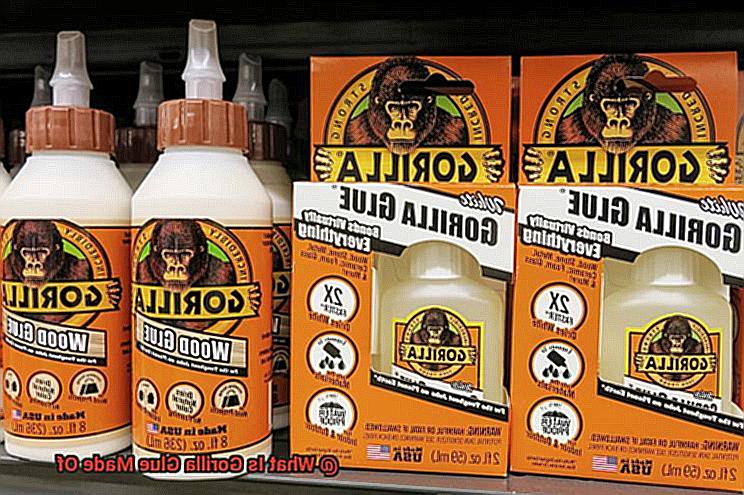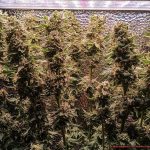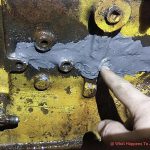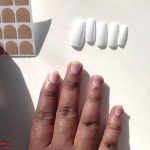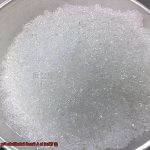Sick of wimpy adhesives that can’t handle the heat?
Say hello to Gorilla Glue, the ultimate adhesive badass. But hold up, have you ever wondered what makes this glue so dang strong?
Well, get ready to dive deep into the wild world of Gorilla Glue. We’re gonna uncover its secret sauce and spill the beans on why it’s tougher than a grizzly bear with a bad attitude.
So, grab a cold one, kick back, and let’s crack open the case of what Gorilla Glue is really made of.
What is Gorilla Glue?
Contents
- 1 What is Gorilla Glue?
- 2 The Key Ingredient: Polyurethane
- 3 Other Components of Gorilla Glue
- 4 Water: An Activator for Polyurethane
- 5 Diisocyanate Prepolymer: Enhancing Adhesive Properties
- 6 Additives: Regulating Curing Time and Increasing Resistance to Moisture, Heat, and Chemicals
- 7 Fillers: Enhancing Versatility and Improving Handling and Application Properties
- 8 How to Apply Gorilla Glue Properly
- 9 Conclusion
When it comes to adhesive strength and versatility, few products can match the mighty Gorilla Glue. This renowned polyurethane adhesive has gained a reputation for its ability to bond a wide range of materials, providing durable and long-lasting results. But have you ever wondered what makes Gorilla Glue so effective? Let’s dive into the fascinating world of this powerful adhesive and explore its unique formulation.
The Ingredients that Make Gorilla Glue Formidable:
- Polyurethane Resin: Derived from petrochemicals, polyurethane resin forms the core of Gorilla Glue’s adhesive properties. It can bond wood, metal, ceramics, stone, glass, and many plastics with exceptional strength and durability.
- Foaming Agent: Gorilla Glue incorporates a foaming agent that expands upon application, filling gaps and irregularities in the bonded materials. This not only strengthens the adhesive bond but also provides insulation and vibration dampening properties.
- Solvent – Diphenylmethane Diisocyanate (MDI): Acting as a cross-linking agent, MDI chemically joins the polyurethane molecules together, creating a tight and durable bond. However, it is essential to handle Gorilla Glue with care due to the potential toxicity of MDI.
- Additives: To control viscosity and improve flow characteristics, Gorilla Glue includes various additives such as fillers and thickeners. These additives ensure proper coverage on different surfaces while making application easier.
- Water: An essential reactive component, water initiates a chemical reaction with the polyurethane resin when exposed to moisture or humidity. This reaction causes Gorilla Glue to cure and form an incredibly strong bond.
Understanding the Context:
Gorilla Glue’s popularity stems from its exceptional bonding strength and versatility in various applications. It is widely used in woodworking, construction, and crafts due to its ability to bond different materials reliably.
Polyurethane, the primary adhesive ingredient, undergoes a chemical reaction with water to form a strong bond. Moisture is necessary for Gorilla Glue to set properly.
Diisocyanate prepolymer expands upon contact with water, filling gaps and enhancing the adhesive properties of Gorilla Glue. This expansion allows the glue to bond effectively even on porous surfaces or irregular shapes.
Additives like PMDI and MDI regulate curing time and increase Gorilla Glue’s resistance to moisture, heat, and chemicals, ensuring long-lasting results.
The inclusion of fillers improves Gorilla Glue’s versatility by allowing it to fill gaps and bond uneven surfaces effectively. Fillers also enhance the glue’s viscosity for better handling and application.
The Key Ingredient: Polyurethane
Polyurethane, the key ingredient in Gorilla Glue, is a versatile polymer that can take on different forms – liquids, foams, and solid materials. It’s not just a fancy word; it’s the secret weapon behind Gorilla Glue’s adhesive superpowers.
So how does polyurethane work its magic? When exposed to moisture or humidity, it undergoes a chemical reaction called curing. This reaction causes the glue to expand and create a bond that is stronger than Hercules himself. Talk about superhero strength.
But that’s not all – the expansion of polyurethane allows it to fill gaps and voids, providing extra strength and stability to the bond. No more worrying about weak spots or cracks in your projects. Gorilla Glue has got you covered.

Another remarkable quality of polyurethane is its ability to bond different materials – wood, metal, glass, ceramics, plastics, you name it. It’s like having a one-size-fits-all adhesive solution for all your needs.
Durability is also a key feature of the polyurethane bond created by Gorilla Glue. It can withstand stress, moisture, and anything else life throws its way. Your projects will stay securely attached for years to come.
However, with great power comes great responsibility. Polyurethane adhesives like Gorilla Glue require proper handling and curing time for optimal results. So make sure to follow the instructions carefully to unleash the full potential of this adhesive superhero.
Other Components of Gorilla Glue
Gorilla Glue isn’t just your ordinary adhesive. It’s a powerhouse of other components that take its performance to the next level. Let’s take a closer look at these ingredients and discover how they contribute to making Gorilla Glue the go-to choice for DIY enthusiasts and professionals alike.
First up, we have the foaming agent. This magical ingredient works wonders by allowing Gorilla Glue to expand and fill gaps. When the glue comes into contact with moisture or air, it expands, ensuring maximum coverage and creating a bond that can withstand the test of time. Say goodbye to those pesky crevices and imperfections, because this foaming agent fills them in like a boss.
Next on our list is the solvent. This component keeps Gorilla Glue in a liquid form, making it incredibly easy to apply. It spreads smoothly and evenly across surfaces, ensuring a seamless adhesive bond. As the glue dries, the solvent evaporates, leaving behind a solid bond that is as strong as it is reliable.
But wait, there’s more. Some versions of Gorilla Glue also contain accelerators or initiators. These little helpers work their magic by speeding up the curing process. Whether you’re working on a time-sensitive project or simply too impatient to wait, these additives ensure that Gorilla Glue sets quickly, so you can move on to the next step of your masterpiece.
Last but not least, let’s talk about those small amounts of other chemicals in Gorilla Glue. Stabilizers and preservatives play a crucial role in maintaining the glue’s shelf life and preventing degradation over time. Because let’s face it, nobody wants to open up a bottle of dried-up glue when inspiration strikes.
Water: An Activator for Polyurethane
Polyurethane adhesives like Gorilla Glue owe their incredible strength and durability to the power of water. Without water, polyurethane remains dormant and won’t cure properly. But when water meets polyurethane, it’s like a match made in glue heaven.
Polyurethane is the main ingredient in Gorilla Glue, and it’s what gives this adhesive its superhero-worthy qualities. So how does water activate polyurethane? It all comes down to a chemical reaction called hydrolysis. When water interacts with polyurethane, it sets off a chain of events that lead to the formation of urea linkages.
These urea linkages are the secret sauce that gives polyurethane its exceptional strength. They act as molecular bridges, creating a tight bond between the adhesive and the surfaces being glued. It’s like building a super-strong bridge over a river of doubt – nothing can break that bond.
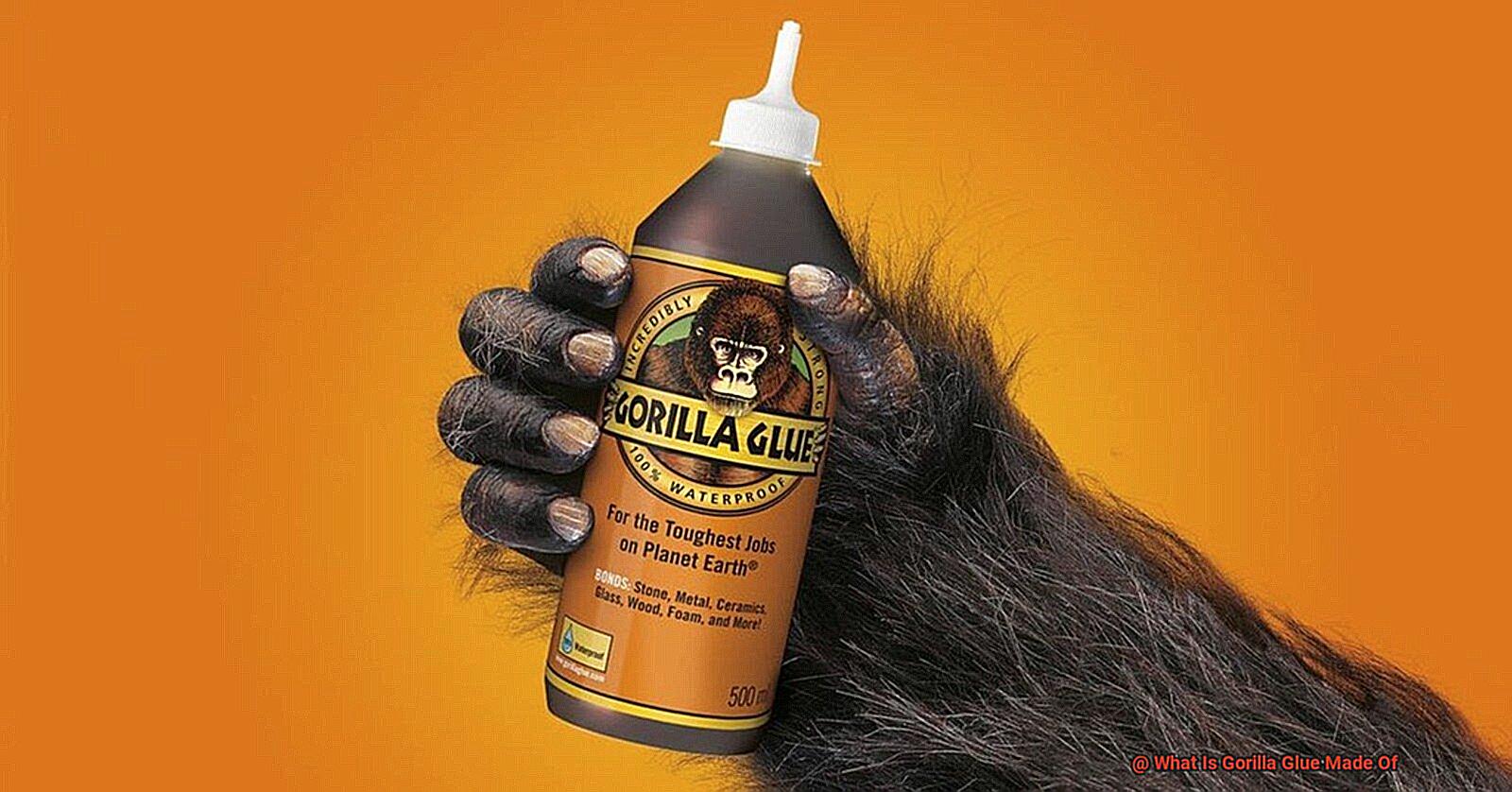
Diisocyanate Prepolymer: Enhancing Adhesive Properties
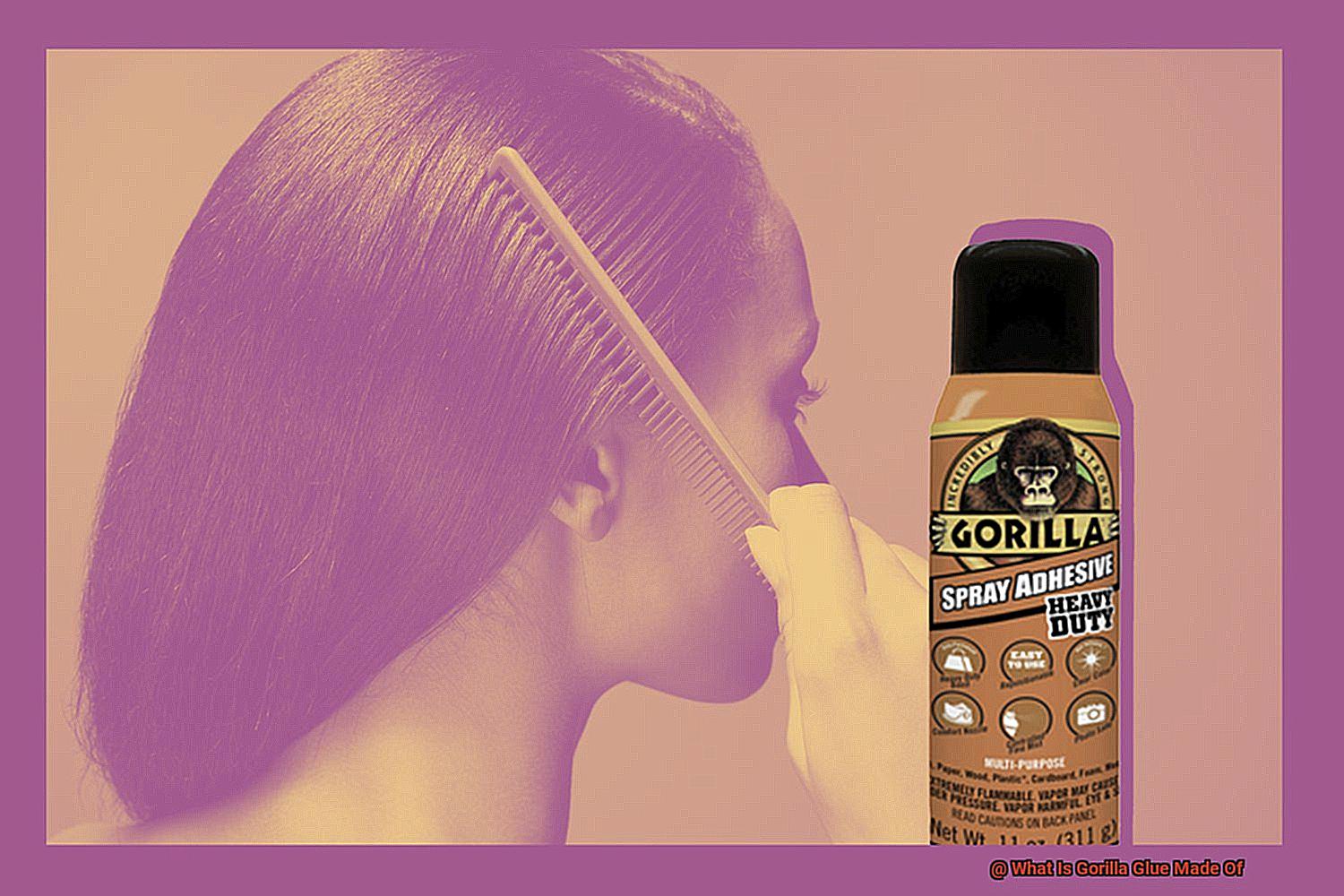
Diisocyanate prepolymer is a game-changer when it comes to enhancing adhesive properties, and it’s the secret ingredient that makes Gorilla Glue one of the most powerful adhesives on the market. So, what exactly is diisocyanate prepolymer? It’s a fancy chemical compound formed by mixing diisocyanates with polyols. But what does that mean for your glue? Let’s break it down.
Diisocyanates are organic compounds that contain two isocyanate functional groups (-NCO). They are the superheroes in this story, providing the backbone for the adhesive magic. One of the rockstar diisocyanates used in Gorilla Glue is methylene diphenyl diisocyanate (MDI), known for its exceptional adhesive properties.
Now, let’s talk about polyols. These alcohol-based compounds contain hydroxyl (-OH) groups and serve as the sidekick to the diisocyanate superhero. Polyols bring flexibility, durability, and resistance to heat and chemicals to the table. In Gorilla Glue, polyether polyol takes center stage.
When these two components come together in a process called polyurethane formation, something incredible happens. The diisocyanates react with the hydroxyl groups of polyols, creating urethane linkages (-NH-CO-O-) and forming long chains of polymer molecules. These chains are responsible for Gorilla Glue’s exceptional adhesive powers.
So, how does diisocyanate prepolymer enhance the adhesive properties of Gorilla Glue? Let’s count the ways:
- Strength and Durability: The polymeric structure created by diisocyanate prepolymer ensures strong bonding between surfaces, meaning your glued items won’t budge, no matter what.
- Flexibility: The long polymer chains provide a touch of elasticity to the glue, allowing it to withstand movements and vibrations without losing its bond. Say goodbye to cracks and breaks.
- Resistance: The chemical bonds formed between the polymer chains create a protective barrier, shielding the adhesive from moisture, heat, and chemicals. Gorilla Glue can handle whatever the world throws at it.
-
Additives: Regulating Curing Time and Increasing Resistance to Moisture, Heat, and Chemicals
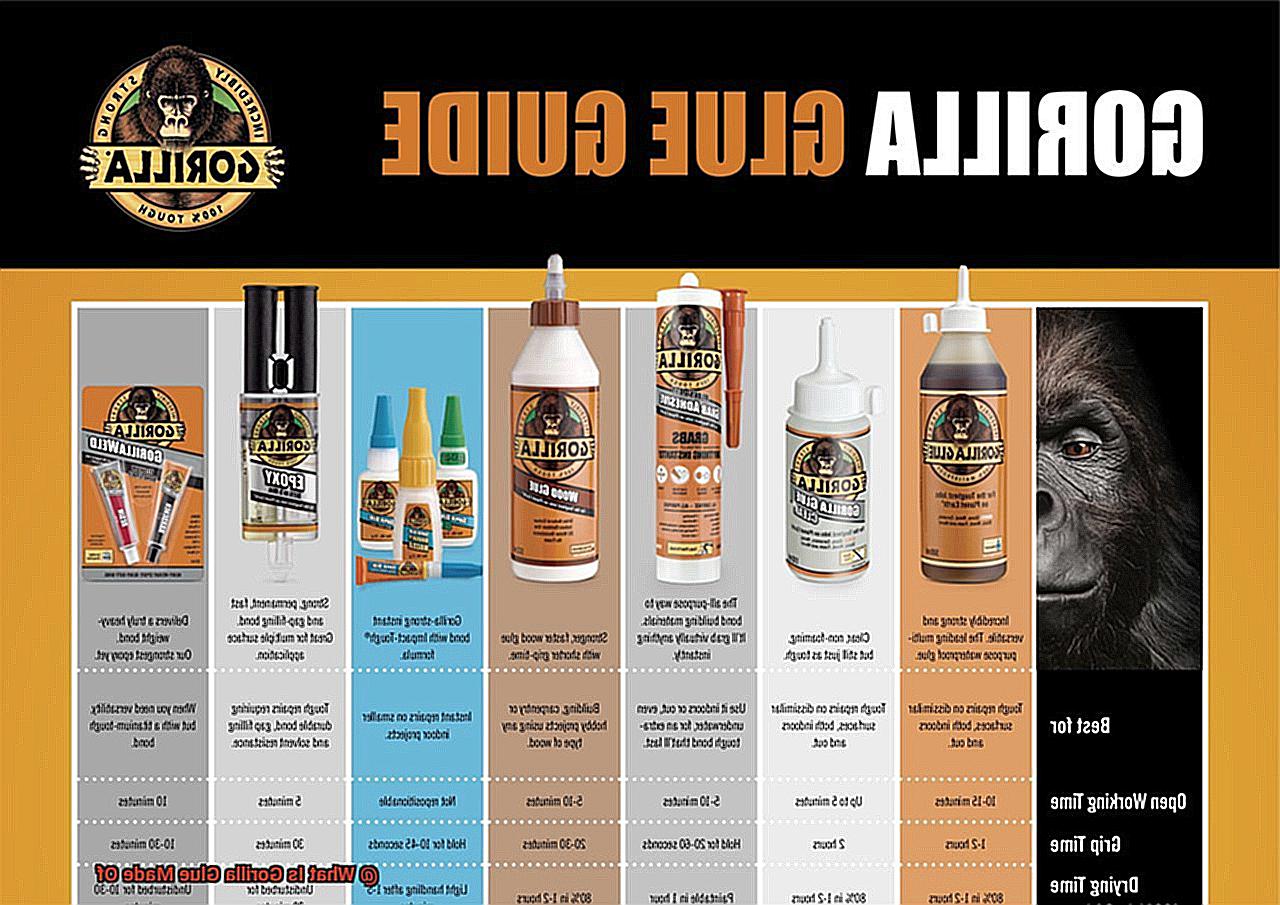
Gorilla Glue, the adhesive powerhouse, owes its incredible performance to a carefully crafted combination of additives that regulate its curing time and enhance its resistance to the most formidable foes: moisture, heat, and chemicals.
Polyurethane, one of the key additives in Gorilla Glue, is renowned for its strength and durability. By incorporating polyurethane into the glue, not only does its overall performance improve, but it also gains resistance to moisture and chemicals. Whether you’re working on a project that demands exposure to water or harsh chemicals, Gorilla Glue rises to the challenge.
But how does Gorilla Glue actually solidify? Enter the curing agent or hardener. This additive initiates a chemical reaction that causes the glue to cure or harden. The curing time depends on the specific formulation of the glue and the intended application. Some Gorilla Glue products boast a quick-curing formula, perfect for those who crave immediate results, while others may require more time to reach their full strength.
To fortify its resistance even further, Gorilla Glue incorporates additional additives like fillers and cross-linking agents. Fillers enhance the glue’s viscosity and gap-filling properties, ensuring a strong bond even on uneven or porous surfaces. Cross-linking agents forge robust chemical bonds within the glue, rendering it impervious to moisture, heat, and chemicals.
Let’s not overlook the solvents in Gorilla Glue. These solvents facilitate application and drying. As they evaporate during curing, they leave behind an unyielding bond that withstands the test of time.
It’s essential to note that Gorilla Glue offers distinct formulations tailored to specific materials such as wood, metal, and fabric. Each formulation meticulously caters to optimize bonding strength and resistance for that particular material.
Fillers: Enhancing Versatility and Improving Handling and Application Properties
These unsung heroes work behind the scenes, transforming glue into a go-to solution for all your bonding needs. In this article, we will explore the different types of fillers used in Gorilla Glue and how they contribute to its remarkable performance.
Calcium Carbonate: The Viscosity Wizard
Calcium carbonate enhances the viscosity of Gorilla Glue, making it easier to control and apply precisely. No more sticky messes or wastage – with calcium carbonate, you can smoothly apply the glue while maintaining its incredible adhesive properties across various materials.
Silica: The Thixotropy Maestro
Silica, a fine powder, gives Gorilla Glue its thixotropic superpowers. This means that the glue has a gel-like consistency at rest but transforms into a fluid-like state under shear stress. This property allows for effortless spreading and application, ensuring a strong bond once cured. Say goodbye to struggles with uneven application.
Aluminum Trihydrate and Microspheres: Lightweights with Heavy Impact
Gorilla Glue also incorporates lightweight fillers like aluminum trihydrate and microspheres. These tiny warriors reduce the density of the glue without compromising its strength. The result? A lighter adhesive that’s easier to work with, reducing fatigue during intense bonding sessions.
Handling Made Easy: Drip-Free Control
Thanks to strategic filler usage, Gorilla Glue offers impeccable handling properties. With modified viscosity and thixotropic behavior, you’ll have precise control over the adhesive flow, eliminating drips and runs. Whether you’re tackling vertical surfaces or overhead applications, Gorilla Glue has got your back.
Unbreakable Bonds: Enhanced Strength and Durability
Fillers not only improve handling but also contribute to the overall strength of the bond. By preventing shrinkage and cracking during the curing process, fillers ensure that your glued objects remain firmly attached, even under stress or load. Now you can trust in Gorilla Glue to deliver unbreakable bonds.
How to Apply Gorilla Glue Properly
Look no further than the miraculous Gorilla Glue. With its unparalleled composition and adhesive prowess, Gorilla Glue has become the holy grail for DIY enthusiasts and professionals alike. In this comprehensive guide, we will walk you through the steps to expertly apply Gorilla Glue for results that will leave you awe-inspired.
Step 1: Purify and Dry Surfaces
Before diving into the world of Gorilla Glue, it is crucial to ensure that the surfaces you plan to bond are absolutely pristine and bone-dry. Bid farewell to dirt and debris with a clean cloth or brush. This preliminary step is paramount as even the tiniest contaminants can mercilessly weaken the bond strength of this extraordinary glue.
Step 2: Apply a Whiff of Magic
In the realm of Gorilla Glue, less truly is more. Gently and sparingly spread a whisper-thin layer of this adhesive onto one of the surfaces. Bear in mind that Gorilla Glue has a knack for expanding as it cures, meaning that an excess of glue can lead to a sticky situation. Embrace restraint and let a small amount go an impressively long way.
Step 3: The Sacred Union
Swiftly bring the two surfaces together after applying the glue, forging an unbreakable alliance. Imbue this union with strength by asserting firm pressure, ensuring a flawless connection between the two surfaces. Should you require additional reinforcement, clamps or weights can come to your aid. This step is an indisputable cornerstone for constructing a bond that even Hercules would envy.
Step 4: Embrace Patience
After uniting the surfaces, allow them to bask undisturbed for a minimum of 1-2 hours, granting the glue ample time to cure. However, should you seek the zenith of bond strength, display an abundance of patience and let the glue cure for a full day. During this sacred period, refrain from subjecting the bonded area to any stress or strain, for it needs tranquility to flourish.
Step 5: Erase Excess Glue
If, by chance, excess glue dares to seep out during the bonding ceremony, banish it promptly with a damp cloth or sponge. Time is of the essence here, as once the glue dries, it metamorphoses into a formidable foe that resists removal.
Step 6: Stash and Shield
Post-Gorilla Glue application, reverently seal the cap and store this magical elixir in a cool and dry sanctuary. Utilizing proper storage techniques ensures that the glue maintains its unparalleled quality and shelf life. In case of any accidental spills or encounters with the skin, cleanse the affected area promptly with soap and water, shielding yourself from potential irritation.
quEM3abDv3s” >
Also Read: Does Gorilla Glue Work on Plastic?
Conclusion
Gorilla Glue, a powerful adhesive, is made up of a unique blend of ingredients.
Its formulation includes polyurethane, which provides exceptional bonding strength. This remarkable glue also contains solvents and additives that enhance its performance and durability.
The combination of these components creates a tough and resilient adhesive that can bond various materials with incredible strength. Whether you’re working on a DIY project or repairing something, Gorilla Glue is the go-to solution for reliable and long-lasting results.
Its composition ensures that it can withstand extreme conditions, making it suitable for both indoor and outdoor applications.

